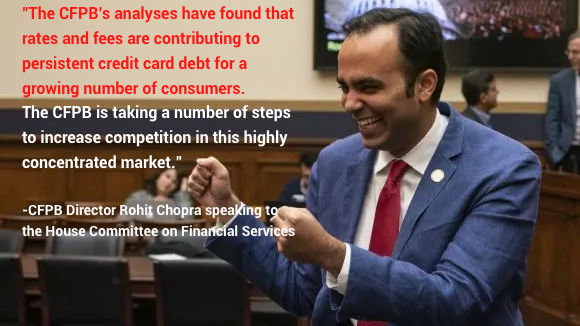With the holidays and 2023 in the rearview, we look forward to items that might have a major impact on your institution this year. First, we have a rundown of the docket of proposed rules coming from the CFPB most likely to affect financial institututions. Also, we look at where the AI hype is, and what might be left when it breaks.
1. CFPB looks to ramp up depth and breadth of oversight
The current backlog of pending rules from the agency points to a few areas that should concern bankers this year.
American Banker provides a short summary of the 5 proposed rules likely to impact financial institutions the most.
- Credit card late fees to be slashed to $8
- Cracking down on illegal overdraft practices, insufficient funds fees
- Consumers should know who has their data and how it is used
- Big Tech firms to get supervised, examined by the CFPB
- CFPB to crack down on third-party data brokers, aggregators
Among the continued focus on noninterest income producing fees and the potential cooling of tech firms further entrance into banking, the last one may signal an even more consequential structural shift in consumer data.
Technically, the CFPB plans to amend the Fair Credit Reporting Act to reclassify data brokers and aggregators as “credit reporting companies.” If enacted, data companies would be prohibited under the FCRA from selling any data for advertising, artificial intelligence and other uses.
Much of the friction in the rulemaking will center on the CFPB’s plans to outlaw the sale of so-called “credit header data,” which is the portion of a credit report that contains an individual’s name, birth date, Social Security number, phone numbers and current and past addresses. Many companies rely on credit header data, and the rule could have a far-reaching impact not just on data brokers.
This signal is yet another example of the growing value of 1st party data for financial institutions. As the last mile provider, the one closest to your customers and market, you have a precious asset. Your information, when properly handled and utilized, can enable insights and service levels to the envy of any national bank or fintech. Positioning your data as a strategic asset, and not just a compliance liability, should be a top priority for any FI looking to get ahead in ‘24.
2. When the AI bubble pops
Technology futurist Cory Doctorow poses an interesting question in his piece What kind of bubble is AI?
So which kind of bubble is AI? When it pops, will something useful be left behind, or will it go away altogether?
In it, he theorizes about the inevitable retreat from excitement (and investment) in AI. What potential “peace dividend” or permanent changes might failed efforts will leave behind. For example, autonomous vehicles:
These are high value – but only if they are also risk-tolerant. The pitch for self-driving cars is “fire most drivers and replace them with ‘humans in the loop’ who intervene at critical junctures.” That’s the risk-tolerant version of self-driving cars, and it’s a failure. More than $100b has been incinerated chasing self-driving cars, and cars are nowhere near driving themselves
For a cart before the horse approach in deploying AI, look no further than Chris Bakke’s hilarious prompt injection interaction with a California car dealer’s chatbot.

Doctorow’s concerns look more towards the risk around both the transient and proprietary nature of some AI investments.
This is a blind spot in our policymakers debates about AI. The smart policymakers are asking questions about fairness, algorithmic bias, and fraud. The foolish policymakers are ensnared in fantasies about “AI safety,” AKA “Will the chatbot become a superintelligence that turns the whole human race into paperclips?”
But no one is asking, “What will we do if” – when – “the AI bubble pops and most of this stuff disappears overnight?
In your own analysis, it is worth considering where the real value lies for whatever use case you are considering. Is it in the platform/application? The underlying data driving models (see above on 1st party data in particular)? The change in business models and approach to customer experience?
In all cases, however, resist the temptation to wish away the issues, and use the often difficult complexity as an excuse to do nothing. Taking a wait-and-see approach to AI and your strategy is valid, but only after thoughtful consideration and a serious look at the alternatives and potential disruption of community banking at large.
After one too many requests, we’re starting a podcast this year for community banking leaders. It’s called Behind the Vault: Conversations with Customer-Driven Bankers. We’re booking our first batch of guests. If you or someone at your institution would like to be highlighted and share your story, apply here: BehindTheVaultPod.com.
And that is it for this first week of ‘24. Here’s a cool look at both how new Lego sets are created, and an homage to one of photography’s most iconic devices?. Click below to let us know how we did:

